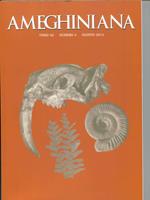Lucas Ernesto Fiorelli, Gerald Grellet-Tinner, Eloisa Argañaraz, Leonardo Salgado
Ameghiniana 50 (4), 389-406, (1 August 2013) https://doi.org/10.5710/AMGH.15.11.2012.523
KEYWORDS: Taphonomic characterization, Nesting site, Paleohydrothermalism, Sanagasta, La Rioja, Argentina, Caracterización tafonómica, Sitio de nidificación, Paleohidrotermalismo
TAPHONOMY OF THE NEOSAUROPOD NESTING SITE FROM SANAGASTA (LA RIOJA, ARGENTINA): EXCEPTIONAL PRESERVATION IN A CRETACEOUS HYDROTHERMAL PALEOENVIRONMENT. The Cretaceous Sanagasta nesting site, La Rioja Province, Argentina, has shed insights on the reproductive behavior of neosauropods, documenting colonial behavior, phylopatry, and an opportunistic environment-dependent-reproduction relationship with their paleoenvironment. The taphonomy of this monotypic nesting site is described in order to assess its biostratinomy and fossil diagenesis. The 3D spatial egg-clutch arrangement is well preserved and suggests the presence of autochthonous associations with in-situ ovipositions, without nesting trace. The egg-bearing level presents a matrix-supported packed biofabric and an “intrinsic” biogenic accumulation that implies a gregarious behavior through their preferential colonization of a specific paleohydrothermal nesting site. The biocenosis of biogenically deposited eggs, with eggshell mineralization is altered by hydrothermal activity, and extremophile microorganisms. The thanatocenosis and time-averaging were virtually null because the eggs buried in the substrate immediately after being laid. In contrast, the taphocenosis represents the most important taphonomic feature. The eggshells display several synchronous taphonomic alterations produced by acidic hot spring solutions, while re-calcification and silicification are the most common eggshell recrystallizations. The presence of microchert, chalcedony, ∼10 μm-diamteer opal-A microspheres, epidote aggregates, several macro-structures, and fibrous clay minerals replacing parts of the eggshell and egg membranes, indicates an extreme hydrothermal alteration under exceptional conditions. The presence of fossil stromatolites, cyanobacterians, and diatoms, coupled with sedimentary structures (microfacies and hydrothermal microfabrics), and with eggs taphonomy imply that the Sanagasta nesting site represents a particular instance of taphocenosis and a Lagerstätte. The Sanagasta dinosaur nesting site is the first documented case of environment-dependent reproduction amongst neosauropods.

